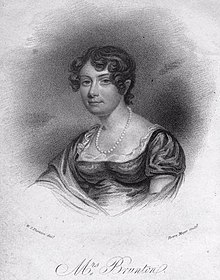
Jane Austen was an English novelist known primarily for her six major novels, which interpret, critique, and comment upon the British landed gentry at the end of the 18th century. Austen's plots often explore the dependence of women on marriage in the pursuit of favourable social standing and economic security. Her works critique the novels of sensibility of the second half of the 18th century and are part of the transition to 19th-century literary realism. Her use of social commentary, realism and biting irony have earned her acclaim among critics and scholars.
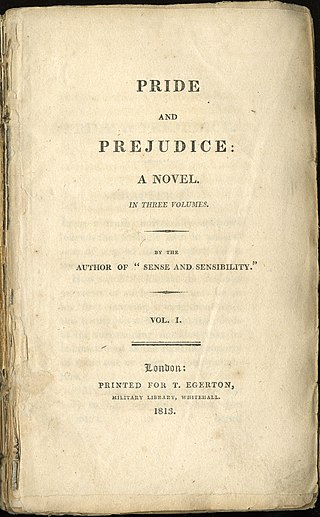
Pride and Prejudice is an 1813 novel of manners by Jane Austen. The novel follows the character development of Elizabeth Bennet, the protagonist of the book, who learns about the repercussions of hasty judgments and comes to appreciate the difference between superficial goodness and actual goodness.

Sense and Sensibility is a novel by Jane Austen, published in 1811. It was published anonymously; By A Lady appears on the title page where the author's name might have been. It tells the story of the Dashwood sisters, Elinor and Marianne as they come of age. They have an older half-brother, John, and a younger sister, Margaret.

Emma is a novel written by Jane Austen. It is set in the fictional country village of Highbury and the surrounding estates of Hartfield, Randalls and Donwell Abbey, and involves the relationships among people from a small number of families. The novel was first published in December 1815, with its title page listing a publication date of 1816. As in her other novels, Austen explores the concerns and difficulties of genteel women living in Georgian–Regency England. Emma is a comedy of manners.
This article contains information about the literary events and publications of 1811.

Lady Susan is an epistolary novella by Jane Austen, possibly written in 1794 but not published until 1871. This early complete work, which the author never submitted for publication, describes the schemes of the title character.
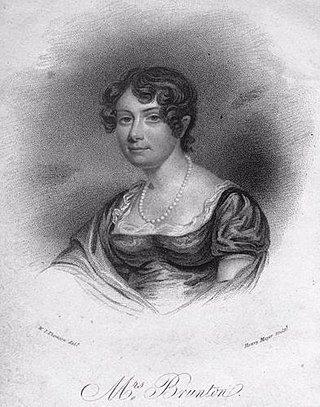
Mary Brunton was a Scottish novelist, whose work has been seen as redefining femininity. Fay Weldon praised it as "rich in invention, ripe with incident, shrewd in comment, and erotic in intention and fact."
Jane West, was an English novelist who published as Prudentia Homespun and Mrs. West. She also wrote conduct literature, poetry and educational tracts.
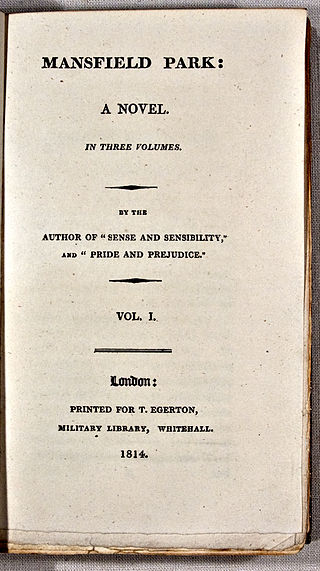
Mansfield Park is the third published novel by Jane Austen, first published in 1814 by Thomas Egerton. A second edition was published in 1816 by John Murray, still within Austen's lifetime. The novel did not receive any public reviews until 1821.
Mary Hays (1759–1843) was an autodidact intellectual who published essays, poetry, novels and several works on famous women. She is remembered for her early feminism, and her close relations to dissenting and radical thinkers of her time including Robert Robinson, Mary Wollstonecraft, William Godwin and William Frend. She was born in 1759, into a family of Protestant dissenters who rejected the practices of the Church of England. Hays was described by those who disliked her as 'the baldest disciple of [Mary] Wollstonecraft' by The Anti Jacobin Magazine, attacked as an 'unsex'd female' by clergyman Robert Polwhele, and provoked controversy through her long life with her rebellious writings. When Hays's fiancé John Eccles died on the eve of their marriage, Hays expected to die of grief herself. But this apparent tragedy meant that she escaped an ordinary future as wife and mother, remaining unmarried. She seized the chance to make a career for herself in the larger world as a writer.

The reception history of Jane Austen follows a path from modest fame to wild popularity. Jane Austen (1775–1817), the author of such works as Pride and Prejudice (1813) and Emma (1815), has become one of the best-known and most widely read novelists in the English language. Her novels are the subject of intense scholarly study and the centre of a diverse fan culture.

Jane Austen lived her entire life as part of a family located socially and economically on the lower fringes of the English gentry. The Rev. George Austen and Cassandra Leigh, Jane Austen's parents, lived in Steventon, Hampshire, where Rev. Austen was the rector of the Anglican parish from 1765 until 1801. Jane Austen's immediate family was large and close-knit. She had six brothers—James, George, Charles, Francis, Henry, and Edward—and a beloved older sister, Cassandra. Austen's brother Edward was adopted by Thomas and Elizabeth Knight and eventually inherited their estates at Godmersham, Kent, and Chawton, Hampshire. In 1801, Rev. Austen retired from the ministry and moved his family to Bath, Somerset. He died in 1805 and for the next four years, Jane, Cassandra, and their mother lived first in rented quarters and then in Southampton where they shared a house with Frank Austen's family. During these unsettled years, they spent much time visiting various branches of the family. In 1809, Jane, Cassandra, and their mother moved permanently into a large "cottage" in Chawton village that was part of Edward's nearby estate. Austen lived at Chawton until she moved to Winchester for medical treatment shortly before her death in 1817.
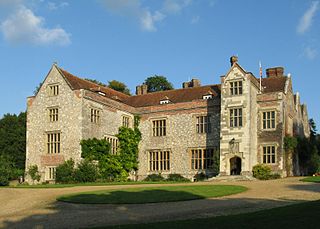
Chawton House is a Grade II* listed Elizabethan manor house in Hampshire. It is run as a historic property and also houses the research library of The Centre for the Study of Early Women's Writing, 1600–1830, using the building's connection with the English novelist Jane Austen.
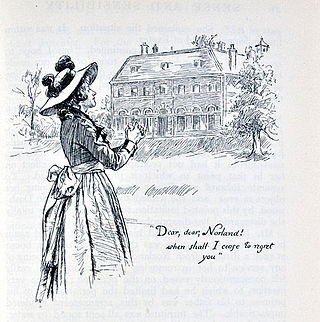
Marianne Dashwood is a fictional character in Jane Austen's 1811 novel Sense and Sensibility. The 16-year-old second daughter of Mr. and Mrs. Henry Dashwood, she mostly embodies the "sensibility" of the title, as opposed to her elder sister Elinor's "sense".

Emmeline, The Orphan of the Castle is the first novel written by English writer Charlotte Smith; it was published in 1788. A Cinderella story in which the heroine stands outside the traditional economic structures of English society and ends up wealthy and happy, the novel is a fantasy. At the same time, it criticises the traditional marriage arrangements of the 18th century, which allowed women little choice and prioritised the needs of the family. Smith's criticisms of marriage stemmed from her personal experience and several of the secondary characters are thinly veiled depictions of her family, a technique which both intrigued and repelled contemporary readers.
Jane Austen's (1775–1817) distinctive literary style relies on a combination of parody, burlesque, irony, free indirect speech and a degree of realism. She uses parody and burlesque for comic effect and to critique the portrayal of women in 18th-century sentimental and Gothic novels. Austen extends her critique by highlighting social hypocrisy through irony; she often creates an ironic tone through free indirect speech in which the thoughts and words of the characters mix with the voice of the narrator. The degree to which critics believe Austen's characters have psychological depth informs their views regarding her realism. While some scholars argue that Austen falls into a tradition of realism because of her finely executed portrayal of individual characters and her emphasis on "the everyday", others contend that her characters lack a depth of feeling compared with earlier works, and that this, combined with Austen's polemical tone, places her outside the realist tradition.
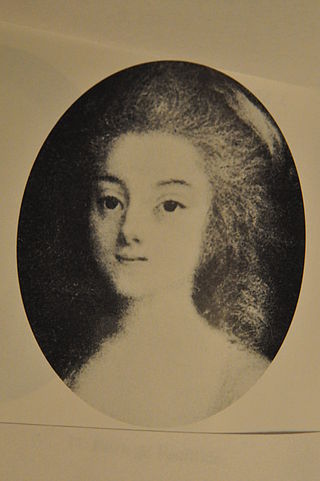
Eliza Capot, Comtesse de Feuillide was the cousin, and later sister-in-law, of novelist Jane Austen. She is believed to have been the inspiration for a number of Austen's works, such as Love and Freindship, Henry and Eliza, and Lady Susan. She may have also been the model from whom the character of Mary Crawford is derived.
Colonel Brandon is a fictional character in Jane Austen's 1811 novel Sense and Sensibility. A quiet and reserved man, he forms an attachment to the middle Dashwood sister, Marianne whom he eventually marries happily.
Plan of a Novel, according to Hints from Various Quarters is a short satirical work by Jane Austen, probably written in May 1816. It was published in complete form for the first time by R. W. Chapman in 1926, extracts having appeared in 1871. It has been said that "in the Plan and the correspondence from which it arose, we have the most important account of what Jane Austen understood to be her aims and capacities as a novelist".
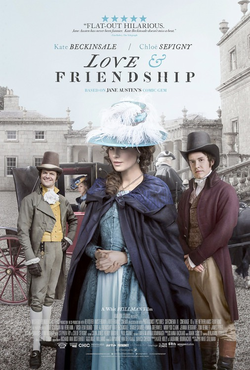
Love & Friendship is a 2016 period comedy film written and directed by Whit Stillman. Based on Jane Austen's epistolary novel Lady Susan, written c. 1794, the film stars Kate Beckinsale, Chloë Sevigny, Xavier Samuel, and Emma Greenwell. The film follows recently widowed Lady Susan in her intrepid and calculating exploits to secure suitably wealthy husbands for her daughter and herself. Although adapted from Lady Susan, the film was produced under the borrowed title of Austen's juvenile story Love and Freindship.
